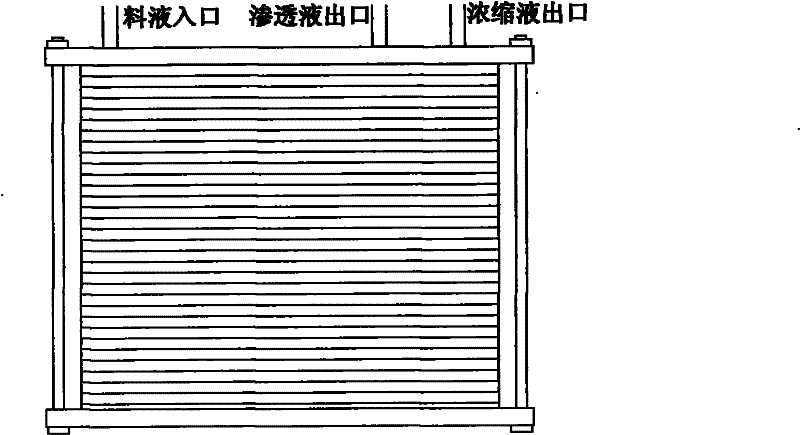Method for purifying ginkgo flavones through membrane separation
A technology of ginkgo flavonoids and purification methods, which is applied in the direction of anti-toxins, medical raw materials derived from gymnosperms, cardiovascular system diseases, etc., can solve the problems of high equipment cost, cumbersome process, and low product purity, and achieve continuous The effects of automation and automation, reduction of environmental pollution, and simple process flow
- Summary
- Abstract
- Description
- Claims
- Application Information
AI Technical Summary
Problems solved by technology
Method used
Image
Examples
Embodiment 1
[0045] Take 300 mg of crude flavonoids and dissolve in 600 mL of ethanol-water with a mass fraction of ethanol of 30%. After filtration, set aside, control the operating pressure at 0.2Mpa, feed liquid temperature at 30°C, select a polyvinylidene fluoride (PVDF) ultrafiltration membrane with a molecular weight cut-off of 500,000dalton for ultrafiltration, ultrafiltration time is 2h, and collect the permeate. After drying the collected permeate, the content of flavonoids was determined. After ultrafiltration, the content of ginkgo flavonoids increased from 24% to 35.2%.
Embodiment 2
[0047] Take 300 mg of crude flavonoids and dissolve in 600 mL of ethanol-water with a mass fraction of ethanol of 30%. After filtration, set aside, control the operating pressure at 0.2Mpa, feed liquid temperature at 40°C, select a polyvinylidene fluoride (PVDF) ultrafiltration membrane with a molecular weight cut-off of 100,000dalton for ultrafiltration, ultrafiltration time is 2h, and collect the permeate. After drying the collected permeate, the content of flavonoids was determined. After ultrafiltration, the content of ginkgo flavonoids increased from 24% to 39.4%.
Embodiment 3
[0049] Take 300 mg of crude flavonoids and dissolve in 600 mL of ethanol-water with a mass fraction of ethanol of 30%. After filtration, set aside, control the operating pressure at 0.25Mpa, feed liquid temperature at 30°C, select a polyacrylonitrile (PAN) ultrafiltration membrane with a molecular weight cut-off of 50,000dalton for ultrafiltration, ultrafiltration time is 2h, and collect the permeate. After drying the collected permeate, the content of flavonoids was determined. After ultrafiltration, the content of ginkgo flavonoids increased from 24% to 40.2%.
PUM
 Login to View More
Login to View More Abstract
Description
Claims
Application Information
 Login to View More
Login to View More - R&D
- Intellectual Property
- Life Sciences
- Materials
- Tech Scout
- Unparalleled Data Quality
- Higher Quality Content
- 60% Fewer Hallucinations
Browse by: Latest US Patents, China's latest patents, Technical Efficacy Thesaurus, Application Domain, Technology Topic, Popular Technical Reports.
© 2025 PatSnap. All rights reserved.Legal|Privacy policy|Modern Slavery Act Transparency Statement|Sitemap|About US| Contact US: help@patsnap.com



